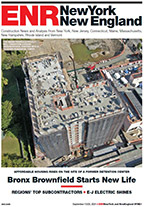New construction starts in September receded 1% to a seasonally adjusted annual rate of $419.5 billion, according to McGraw-Hill Construction, a division of The McGraw-Hill Cos. Both nonresidential building and housing fell back after their improved pace in August.
Meanwhile, the nonbuilding construction sector, comprised of public works and electric utilities, strengthened for the second month in a row after weakening in early summer. For the January-September period of 2011, total construction starts on an unadjusted basis were reported at $314.1 billion, down 5% from the same period a year ago.
The September statistics lowered the Dodge Index to 89 (2000=100), compared to the August reading of 90. “The volume of construction starts continues to hover within a set range, not yet able to gain sufficient momentum for expansion to take hold,” said Robert A. Murray, vice president of economic affairs for McGraw-Hill Construction.
“For a variety of reasons, this extended plateau is likely to last a while longer. Tight budget conditions at the federal, state, and local levels of government are restraining the amount of construction that’s taking place for the institutional building and public works sectors, notwithstanding the occasional upturn such as shown by public works in September. The slow pace of job creation and widespread uncertainty about the economy are causing developers and lenders to remain hesitant about new commercial projects, and they’re also causing potential homebuyers to remain wary about going ahead with home purchases.”
Nonresidential Building
Nonresidential building in September dropped 13% to $131.8 billion (annual rate). The institutional side of the nonresidential market retreated overall, pulled down in particular by a 24% drop for health-care facilities after the 92% jump for this category in August.
Several large hospital projects, valued each in the range of $164 million to $385 million, had provided the August lift. While September showed that large hospital projects continued to reach groundbreaking, they were generally smaller than what had been reported in the previous month. The large hospital projects in September, valued each at $100 million or more, were located in Delaware ($180 million), Colorado ($128 million), New York ($109 million), Illinois ($104 million), and California ($100 million).
Also falling sharply in September were the public buildings category (comprised of courthouses, detention facilities, and military work), which plunged 36%; and the amusement-related category which dropped 22%. Cushioning the institutional downturn was a slight 1% increase for educational buildings, helped by the start of two large college buildings, valued each at $92 million, located in Philadelphia and San Diego, with additional support coming from the start of a $79-million high school in Yakima, Wash., and a $71-million high school in Virginia Beach, Va.
Church construction in September edged up 6% from a low level, and the often volatile transportation terminal category advanced 90%, reflecting the boost coming from a $132-million project to rehabilitate and retrofit rail substation and ventilation facilities in Queens, N.Y.
The commercial building categories in September featured large declines for warehouses, down 48%; and hotels, down 21%. Office construction in September improved 11%, helped by the start of a $100-million data center in Suwanee, Ga., and an $80-million renovation of a federal office building in Houston. Store construction also saw greater activity in September, rising 15%. The manufacturing plant category in September fell 45%, continuing to retreat from its heightened activity in June and July.
Residential Building



